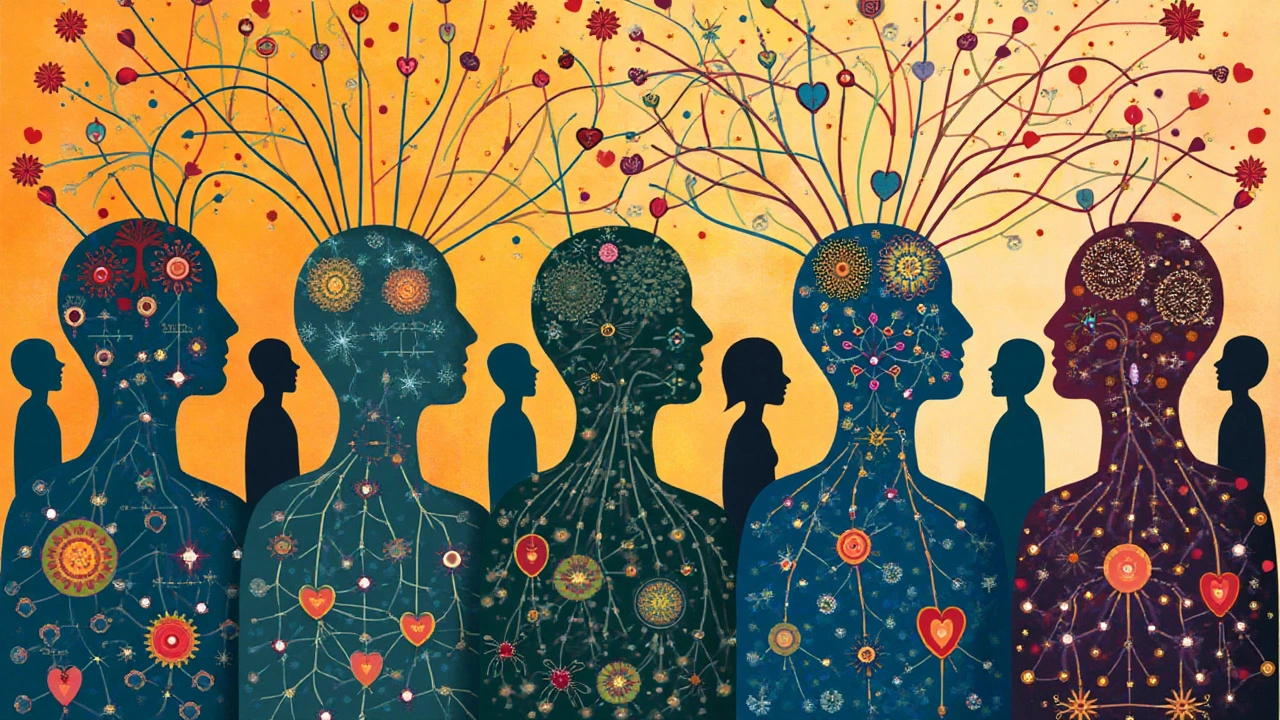
Delving into the realm of mental health unveils a landscape where some illnesses pose significant challenges for treatment. These illnesses, often complex in nature, come with a myriad of symptoms that can fluctuate in intensity and form. At the forefront of these difficulties are conditions such as personality disorders, schizophrenia, and treatment-resistant depression, each presenting an intricate puzzle for both patients and healthcare providers.
Successful treatment is not just about addressing the symptoms; it's about understanding the human beneath the disorder. The therapeutic approach must be as unique as the individuals it aims to serve, taking into account their personal histories and the environmental factors that contribute to their mental health status. As we explore this topic, we look at the ongoing efforts in research and practice to make headway against these formidable challenges.
- Understanding Complex Mental Illnesses
- Challenges in Diagnosis and Treatment
- The Role of Co-occurring Disorders
- Emerging Therapies and Innovations
- Fostering a Supportive Environment
Understanding Complex Mental Illnesses
Navigating the turbulent waters of mental health reveals how profoundly intricate complex mental illness can be. These disorders aren't merely a collection of symptoms but are deeply ingrained in the fabric of an individual’s life and identity. Disorders like schizophrenia, borderline personality disorder, and chronic depression require a nuanced understanding that goes beyond general psychological frameworks. Each of these conditions, while distinct, often shares overlapping symptoms which complicate their diagnosis and treatment.
At the forefront of these intricate disorders is schizophrenia, a debilitating condition marked by distortions in thinking, perception, emotions, and even self-awareness. People with schizophrenia struggle to distinguish what is real from fantasy, and this blurred line can lead to behaviors that alienate them from friends and family. Research has shown that genetics play a significant role in its emergence, yet environmental factors, such as prenatal stressors and psycho-social stress, equally contribute to its complexities.
Similarly, borderline personality disorder (BPD) presents its own challenges with patterns of instability in relationships, self-image, and emotions. For those suffering from BPD, emotional turbulence can feel like navigating a storm without an anchor, often resulting in impulsive behavior and a pervasive fear of abandonment. It's important to note that BPD is frequently co-morbid with other mental health issues, such as anxiety and substance abuse, which can further obscure a clear treatment pathway.
David Anderson, Ph.D., a clinical psychologist, once noted, "Untangling mental disorders is like peeling an onion; each layer reveals new insights, yet leaves us with more layers to understand."
Lastly, conditions like treatment-resistant depression showcase the relentless nature of certain mental illnesses. This form of depression persists despite undergoing multiple therapeutic interventions, and it is a stark reminder that our understanding of mental health treatment is still evolving. Recent studies highlight the potential role of neuroplasticity in addressing treatment-resistant depression, suggesting that the brain's ability to reorganize itself holds keys to future solutions.
While these examples illustrate just a fraction of complex mental health challenges, they emphasize the importance of continued research. The dynamic nature of mental health disorders calls for adaptive treatment models that can cater to individual needs. New approaches such as personalized medicine, which tailors treatment plans based on genetic and environmental profiles, are gaining traction. As our understanding grows, so too does our hope for more effective interventions that can offer relief to those in need.
Challenges in Diagnosis and Treatment
Diagnosing mental illnesses, particularly complex ones, remains a daunting task for even seasoned mental health professionals. Unlike physical ailments, where imaging and blood tests can pinpoint a problem, mental health diagnoses rely heavily on behavioral assessments and patient history. This inherently subjective approach can lead to variances in diagnosis, especially with mental illness symptoms that manifest differently across individuals. For instance, two patients with schizophrenia might experience vastly different patterns of delusions and hallucinations, complicating the treatment process.
Moreover, the overlapping symptoms across various mental health disorders add another layer of complexity. Depression and anxiety, for example, often co-exist, muddling a clear diagnosis. Highlighting this issue, the American Psychiatric Association notes that comorbidity can often obscure the clinical picture, leading to challenges in determining the primary disorder needing treatment. A correct diagnosis is crucial as it steers the course of treatment; a misdiagnosis can lead not only to ineffective treatment but can exacerbate symptoms, causing harm to the patient.
As mental health therapy evolves, there is an increasing emphasis on personalized treatment plans. The idea is to tailor therapy to accommodate the unique blend of symptoms and personal history each patient presents. However, this approach requires significant time and resources, often in short supply in public health systems. Many professionals now advocate for interdisciplinary treatment teams that can provide a more well-rounded approach, although effectively coordinating such teams presents logistical challenges.
Compounding these diagnostic hurdles is the stigma around mental illness, which can prevent individuals from seeking help in the first place. Many suffer in silence, allowing their conditions to worsen and become more difficult to treat. This societal barrier necessitates not just clinical intervention but a cultural shift towards greater awareness and acceptance of mental health issues. In this regard, public education campaigns and mental health literacy programs play a vital role in encouraging early intervention and dispelling misconceptions.
"Diagnosis of mental health conditions requires a multi-pronged approach, incorporating not just clinical evaluations but also input from family, educators, and other stakeholders," says Dr. Jane Phillips, a leading psychiatrist known for her work in mental health reform.
Finally, technology stands as a double-edged sword in addressing these challenges. On one hand, digital tools like telepsychiatry and mental health apps offer promise in reaching underserved populations and providing consistent monitoring. On the other hand, they present new challenges in terms of data privacy and the digital divide that still persists in many regions. These tools must be integrated thoughtfully into treatment plans to be effective. Thus, mental health professionals are tasked with not only addressing clinical needs but also navigating the broader social and technological landscape that impacts treatment.

The Role of Co-occurring Disorders
In the realm of mental health, co-occurring disorders present an intricate challenge that often complicates the treatment of mental illnesses. These disorders, commonly referred to as comorbid conditions, involve the simultaneous presence of two or more mental health disorders or a combination of mental and substance use disorders in the same individual. This dual-diagnosis scenario can significantly affect the trajectory of treatment, as each condition may influence the symptoms and outcome of the other, creating a complex therapeutic landscape for practitioners to navigate. According to the Substance Abuse and Mental Health Services Administration, nearly 9.2 million adults in the United States had co-occurring mental health and substance use disorders in 2020. This statistic underscores the magnitude of this challenge in a clinical setting.
The presence of co-occurring disorders often necessitates a nuanced treatment approach that recognizes and addresses the interaction between multiple conditions. For instance, a person suffering from both major depressive disorder and alcohol dependence might find that their depressive symptoms are exacerbated by alcohol consumption, while simultaneously using alcohol as a coping mechanism. This vicious cycle can impede progress and make traditional treatment methods less effective. Clinicians must devise integrated treatment plans that account for the combined influences of these disorders, often requiring a multi-disciplinary approach involving both psychotherapeutic interventions and pharmacological support.
Compounding these challenges are the difficulties in accurately diagnosing co-occurring disorders. Symptoms of one disorder can mask or mimic those of another, leading to potential misdiagnosis and, consequently, ineffective treatment plans. Mental health professionals often rely on comprehensive assessments and long periods of observation to distinguish between overlapping symptoms. Early intervention and accurate diagnosis can play a pivotal role in improving treatment outcomes for individuals with multiple conditions. As stated by Dr. Bruce J. Cohen, "Understanding the complex interaction between co-occurring disorders and crafting a tailored approach is key to successful patient outcomes."
"Diagnosing co-occurring disorders demands a sophisticated understanding of mental health and a careful, patient-centered approach to treatment," said Dr. Jamie Howard, Senior Clinical Psychologist at the Child Mind Institute.
As research into co-occurring disorders grows, new treatment methodologies are being developed. Integrated treatment models, which combine services for mental health and substance use into a cohesive program, have shown promise in treating these patients more effectively. By tackling all aspects of a patient's health in tandem, these models aim to reduce the fragmented care that often plagues individuals with co-occurring disorders. Emphasizing the need for collaboration among healthcare providers, integrated models foster a supportive environment where patients can receive comprehensive care tailored to their unique conditions. As we continue to understand these challenges, the mental health community remains committed to refining their strategies, with the ultimate goal of enhancing the quality of life for those affected by co-occurring disorders.
Emerging Therapies and Innovations
In recent years, the world of mental health treatment has witnessed a surge in innovative approaches aimed at tackling the most challenging mental illnesses. As our understanding of the brain's complexity deepens, therapies are evolving beyond traditional methods. One area garnering attention is the use of psychedelics in controlled therapeutic settings. Substances like psilocybin, derived from "magic mushrooms," and MDMA, often known as ecstasy, are showing promise when used under clinical guidance. Studies indicate that these substances can help pave new neural pathways, offering relief where typical antidepressants may fail.
The rise of digital therapy platforms and mobile health apps also marks a significant innovation. These tools are not meant to replace traditional psychotherapy but to complement it, making mental health resources more accessible to those who need them. Technologies like virtual reality (VR) are being applied to treat conditions such as PTSD and phobias. By simulating real-world scenarios in a controlled environment, VR therapy allows patients to confront their fears or past experiences in a safe setting, gradually reducing their symptoms over time. This method has shown effectiveness in providing immersive exposure therapy, which can be particularly beneficial for those suffering from severe anxiety disorders.
Co-occurring disorders present another layer of complexity in treatment, and emerging therapies are taking a holistic approach. Integrated treatment models that address both mental illness and substance use disorders are gaining traction. These models advocate for the synchronized treatment of co-occurring disorders, emphasizing the interplay between psychological and physical health. By treating the whole person, rather than just the symptoms, these models aim to improve overall treatment outcomes.
Youth-focused interventions are progressing, with research increasingly supporting school-based mental health programs and resilience training as proactive measures. These efforts seek to equip young people with the skills needed to manage stress and emotional challenges before they escalate into serious mental illness. Schools are becoming incubators for mental wellness, fostering environments where students can develop empathy, self-awareness, and coping strategies.
The concept of neurofeedback, which involves real-time reports of brain activity, is gaining traction as a non-invasive therapy. By providing individuals with feedback on how their brains are functioning, this technique helps them learn to regulate their brain activity, potentially reducing the symptoms of conditions like ADHD and depression. Although this approach is relatively new, its potential benefits highlight the need for continued research and refinement.
"The pace of advancement in mental health technologies is relentless, with new tools emerging every year that are reshaping the landscape," says Dr. Eva Jiang, noted psychologist and author. "It's a time of hope and transformation as we get closer to finding solutions that work on a deeper level."
As these innovations continue to develop, the hope is that they will make mental health care more effective and personalized, offering solutions tailored to individual needs. While the journey is ongoing, these emerging therapies signal a promising future in the realm of mental health treatment.

Fostering a Supportive Environment
Creating a supportive environment is crucial for effectively addressing the challenges of treating complex mental illnesses. It's not just about what happens within therapy sessions, but the entire social fabric that surrounds an individual. Family, friends, workplaces, and communities all play an essential role in shaping this environment. Often, misunderstandings or stigma surrounding mental health can exacerbate symptoms or deter individuals from seeking necessary treatment. Addressing these societal issues can significantly enhance the healing process.
Education forms the backbone of any supportive environment. By equipping those around individuals with mental illnesses with knowledge about these conditions, one can create a more understanding and accepting atmosphere. Notably, the National Alliance on Mental Illness (NAMI) offers workshops and resources aimed at helping families and communities better understand mental health conditions. Such initiatives can dispel myths and reduce associated stigma, enabling more open conversations about mental health.
Another crucial element is involving family members in treatment plans. Family therapy sessions provide a platform to understand dynamics that may influence an individual's mental health. These sessions can offer insights into triggers and stressors, empowering families to adjust their responses to support recovery. Professional guidance helps in developing strategies to communicate more effectively and compassionately.
In settings like workplaces, policies that promote mental well-being are gaining recognition. Implementing flexible working hours, mental health days, and offering access to counselling services can nurture a supportive professional environment. Organizations see the value in retaining healthy employees and hence are starting to adopt a more holistic approach to employee well-being. A study by the World Health Organization reported that for every $1 invested in scaling up mental health treatment, there is a $4 return in improved health and productivity.
Ongoing support groups also make a significant difference outside of formal therapy. These groups, whether facilitated by mental health professionals or peers, provide individuals a safe space to express themselves and learn from others' experiences. The sense of not being alone in one's journey can be incredibly reassuring and motivating. Often, peer support can complement traditional therapy by offering perspectives that even the most skilled therapist may not provide.
Finally, digital platforms are blurring geographical barriers, providing access to support and resources across the globe. Whether through online therapy sessions, community forums, or apps focused on mental well-being, technology is a valuable tool in fostering supportive networks. These platforms can be particularly beneficial for individuals in remote areas or those who prefer anonymity when discussing their mental health.
"Mental health awareness is not just a trend; it’s an essential shift towards a healthier world for everyone," says Dr. Jane Smith, a renowned psychologist in her field. Her emphasis on awareness underscores the need for societal change to create environments where individuals feel safe to discuss and seek help for their mental health challenges.








